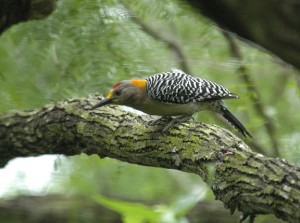Splitting the Golden-fronted Woodpecker
 The taxonomy of the Golden-fronted Woodpecker and its relatives has been causing headaches for over a century. Not only does the species display complex geographic variation in plumage, but where ranges meet, it hybridizes with the closely related Gila Woodpecker to the northwest, the Red-bellied Woodpecker to the northeast, and the Hoffman’s Woodpecker to the south, which in turn sometimes hybridizes with the Red-crowned Woodpecker in Costa Rica. The result is a mind-bending mosaic of similar-looking woodpeckers stretching from Ontario to Venezuela.
The taxonomy of the Golden-fronted Woodpecker and its relatives has been causing headaches for over a century. Not only does the species display complex geographic variation in plumage, but where ranges meet, it hybridizes with the closely related Gila Woodpecker to the northwest, the Red-bellied Woodpecker to the northeast, and the Hoffman’s Woodpecker to the south, which in turn sometimes hybridizes with the Red-crowned Woodpecker in Costa Rica. The result is a mind-bending mosaic of similar-looking woodpeckers stretching from Ontario to Venezuela.
Current taxonomy draws species boundaries despite the hybridization, in part due to differences in vocalizations. For example, Red-bellied and Hoffmann’s Woodpeckers both give a long, churring rattle call that Golden-fronted lacks. Vocal differences probably help the woodpeckers keep each other straight in areas where ranges meet, making them more likely than not to choose a mate of their own taxon, keeping the level of gene flow low and maintaining the boundary between the species in the long term.
As I was going through the Golden-fronted Woodpecker recordings in my collection, some of which are from Texas and some of which are from Mexico, I realized that at least one call in the Golden-fronted repertoire varies geographically. Birds in southern Texas and northern Mexico give a rough, single-syllabled “gaf” call rather like that of the Red-bellied Woodpecker:
But birds from Veracruz south give a distinctive, two-syllabled “CHUCK-a”:
These differences hold up in every recording I’ve managed to find of this call type. The single-note “gaf” can be heard at least as far north as the Texas Panhandle and as far south as San Luis Potosi. The double-noted “CHUCK-a” has been recorded not only in Veracruz but also in Guatemala and El Salvador.
It turns out that these differences almost exactly mirror the geographic boundaries between two major subspecies groups. The “aurifrons group” is the “classic” Golden-fronted Woodpecker of Texas and northern Mexico. The double-noted birds appear to correspond to the “santacruzi” group, which is found from Veracruz all the way south to Honduras (including the “polygrammus” group of southern Pacific-slope Mexico). It’s worth noting that the subspecies dubius from the Yucatan Peninsula apparently gives a slightly different version of the two-syllabled call, more of a “chuck-trrr” [1 2], sometimes shortened to a single-noted “chuck” rather like the call of aurifrons [3].
A 2009 genetic analysis by Erick García-Trejo and colleagues found that the “aurifrons” group and the “santacruzi” group were genetically distinct, with northern aurifrons more closely related to the Red-bellied Woodpecker, Melanerpes carolinus, than to southern birds. As announced in Birding magazine and elsewhere, this set the stage for a formal split of the species by the AOU into Golden-fronted Woodpecker (M. aurifrons) and Velasquez’s Woodpecker (M. santacruzi). However, nobody has apparently submitted a formal proposal to the North American Checklist Committee yet — so I took it upon myself to do that. Sometime later this year, we’ll find out what they say!